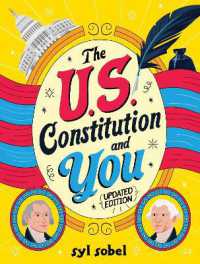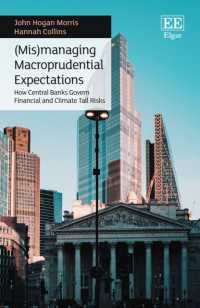Full Description
The essays collected in offer close analysis of an array of cultural representations of the Canada-US border, in both site-specificity and in the ways in which they reveal and conceal cultural similarities and differences. Contributors focus on a range of regional sites along the border and examine a rich variety of expressive forms, including poetry, fiction, drama, visual art, television, and cinema produced on both sides of the 49th parallel.
The field of border studies has hitherto neglected the Canada-US border as a site of cultural interest, tending to examine only its role in transnational policy, economic cycles, and legal and political frameworks. Border studies has long been rooted in the US-Mexico divide; shifting the locus of that discussion north to the 49th parallel, the contributors ask what added complications a site-specific analysis of culture at the Canada-US border can bring to the conversation. In so doing, this collection responds to the demands of Hemispheric American Studies to broaden considerations of the significance of American culture to the Americas as a whole - bringing Canadian Studies into dialogue with the dominantly US-centric critical theory in questions of citizenship, globalization, Indigenous mobilization, hemispheric exchange, and transnationalism.
Contents
Parallel Encounters: Culture at the Canada-Border, edited by Gillian Roberts and David Stirrup
Acknowledgements
1. Introduction: Culture at the 49th Parallel: Nationalism, Indigeneity, and the Hemispheric Gillian Roberts and David Stirrup
Popular Culture and/at the Border
2. Queer(y)ing Fur: Reading Fashion Television's Border Crossings Jennifer Andrews
3. Meanings of Health as Cultural Identity and Ideology Across the Canada-US Border Jan Clarke
4. Television, Nation, and National Security: CBC's The Border Sarah A. Matheson
5. ""Normalizing Relations"": The Canada/Cuba Imaginary on the Fringe of Border Discourse Joanne C. Elvy and Luis René Fernández Tabío
6. How, Exactly, Does the Beaver Bite Back? The Case of Canadian Students Viewing Paul Haggis's Crash Lee Easton and Kelly Hewson
Indigenous Cultures and North American Borders
7. Discursive Positioning: A Comparative Study of Postcolonialism in Native Studies Across the Canada-US Border Maggie Ann Bowers
8. Strategic Parallels: Invoking the Border in Thomas King's Green Grass, Running Water and Drew Hayden Taylor's In a World Created by a Drunken God Gillian Roberts
9. Waste-full Crossings in Thomas King's Truth & Bright Water Catherine Bates
10. Bridging the Third Bank: Indigeneity and Installation Art at the Canada-US Border David Stirrup
11. Cross-Border Identifications and Dislocations: Visual Art and the Construction of Identity in North America Sarah E.K. Smith
12. Conversations That Never Happened: The Writing and Activism of Gloria Anzaldúa, Maria Campbell, and Howard Adams Zalfa Feghali
Theorizing the Border: Literature, Performance, Translation
13. ""Some Borders Are More Easily Crossed Than Others"": Negotiating Guillermo Verdecchia's Fronteras Americanas Maureen Kincaid Speller
14. Discounting Slavery: The Currency Wars, Minstrelsy, and ""The White Nigger"" in T.C. Haliburton's The Clockmaker Jade Ferguson
15. Detained at Customs: Jane Rule, Censorship, and the Politics of Crossing the Canada-US Border Susan Billingham
16. Strangers in Strange Lands: Cultural Translation in Gaétan Soucy's Vaudeville! Jeffrey Orr
17. Bodies of Information: Cross-Border Poetics in the Twenty-First Century Nasser Hussain
18. Bordering on Borders: Dream, Memory, and Allegories of Writing Lynette Hunter
Notes on Contributors
Index







